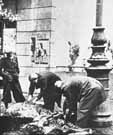
|
|
|

|

|

|

|
|
Click on an image to see a larger, more detailed picture.
|
|
|
|
|
| 1940: Machinery of Hatred |

|
pg. 205 |

|
|
|
|
| |
 Although mothers tried desperately to hide and protect their children, few as young as this child, tattooed with the number 23141, survived Auschwitz. In the concentration camps, work provided the only hope of survival, a possibility foreclosed to the very young and the elderly. As Auschwitz moved into its final, extermination-camp phase, some children, especially twins, escaped the gas chambers upon arrival only to be subjected to cruel medical experiments.
Although mothers tried desperately to hide and protect their children, few as young as this child, tattooed with the number 23141, survived Auschwitz. In the concentration camps, work provided the only hope of survival, a possibility foreclosed to the very young and the elderly. As Auschwitz moved into its final, extermination-camp phase, some children, especially twins, escaped the gas chambers upon arrival only to be subjected to cruel medical experiments.
Photo: Dokumentationsarchiv des Österreichischen Widerstandes / United States Holocaust Memorial Museum Photo Archive
|
 Residents of the Warsaw Ghetto cut up dead horses for meat. This was a violation of Kosher laws, but some Jews felt compelled to abandon these rules under the extraordinary conditions imposed on them by life in the ghetto. Many Jews survived only because of their willingness to eat non-Kosher food.
Residents of the Warsaw Ghetto cut up dead horses for meat. This was a violation of Kosher laws, but some Jews felt compelled to abandon these rules under the extraordinary conditions imposed on them by life in the ghetto. Many Jews survived only because of their willingness to eat non-Kosher food.
Photo: Archive Photos
|
 Accompanied by German Foreign Minister Joachim von Ribbentrop (near left) and Army Chief of Staff General Wilhelm Keitel (far left), Soviet Foreign Commissar Viacheslav Molotov reviews German troops during a visit to Berlin in November 1940. Ribbentrop and Molotov were the architects of the Soviet-German Non-Aggression Pact, which secretly divided Poland between the two countries and formed the basis of their peaceful coexistence. Still in effect in 1940, the pact delayed an eventual military confrontation between the Soviet Union and Nazi Germany, two ideological enemies.
Accompanied by German Foreign Minister Joachim von Ribbentrop (near left) and Army Chief of Staff General Wilhelm Keitel (far left), Soviet Foreign Commissar Viacheslav Molotov reviews German troops during a visit to Berlin in November 1940. Ribbentrop and Molotov were the architects of the Soviet-German Non-Aggression Pact, which secretly divided Poland between the two countries and formed the basis of their peaceful coexistence. Still in effect in 1940, the pact delayed an eventual military confrontation between the Soviet Union and Nazi Germany, two ideological enemies.
Photo: United States Holocaust Memorial Museum Photo Archive
|
|

|

|

|

|
 October 3, 1940: Vichy (Occupied) France passes antisemitic legislation. Vichy's anti-Jewish laws, the first Statut des Juifs, are modeled on the German Nuremberg Laws, and, like them, are widely accepted. Passed in anticipation of Nazi pressure, the laws' primary aims are to force Jews out of public service, teaching, financial occupations, public relations, and the media.
October 3, 1940: Vichy (Occupied) France passes antisemitic legislation. Vichy's anti-Jewish laws, the first Statut des Juifs, are modeled on the German Nuremberg Laws, and, like them, are widely accepted. Passed in anticipation of Nazi pressure, the laws' primary aims are to force Jews out of public service, teaching, financial occupations, public relations, and the media.
|
 October 4, 1940: German law gives Vichy France the power to imprison Jews even inside the Unoccupied Zone.
October 4, 1940: German law gives Vichy France the power to imprison Jews even inside the Unoccupied Zone.
|
 October 12, 1940: On this Jewish Day of Atonement, German loudspeakers in Warsaw, Poland, announce that all Jews in the city must move to the Jewish ghetto by the end of the month.
October 12, 1940: On this Jewish Day of Atonement, German loudspeakers in Warsaw, Poland, announce that all Jews in the city must move to the Jewish ghetto by the end of the month.
|
 October 14, 1940: The Nazis move non-Jews out of a designated section of Warsaw, Poland, and import Jews to replace them.
October 14, 1940: The Nazis move non-Jews out of a designated section of Warsaw, Poland, and import Jews to replace them.
|
 October 20, 1940: More than 7000 Jews from the Saar region of Germany are interned at the camp at Gurs, France.
October 20, 1940: More than 7000 Jews from the Saar region of Germany are interned at the camp at Gurs, France.
|
|
|
|
|
| 1940: Machinery of Hatred |

|
pg. 205 |

|
|
The Holocaust Chronicle
© 2009 Publications International, Ltd.
|
|
